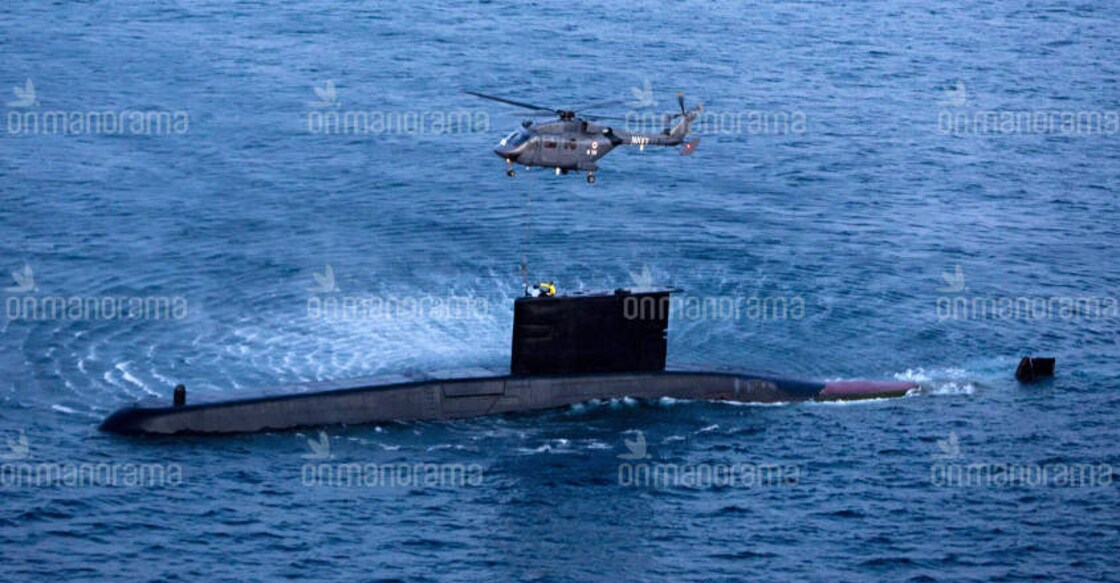Advanced Light Helicopter gives teeth to Navy's airborne ops | Videos

Mail This Article
Kochi: The Advanced Light Helicopter (ALH) 'Dhruv' inducted into the Indian Navy in 2003 has steadily become one of the go-to platforms undertaking multi-role missions. Despite the initial hiccups the Indian Navy had with this naval variant, the ALH's enhanced capabilities have given teeth to Indian Navy's operations from 'INS Garuda', the Naval Air Station under the Southern Naval Command (SNC), here.
The Squadron commissioned as INAS 322 (Guardians) in 2013, operating the ALHs, is presently commanded by Cdr Hari Govind R. In the last five years the squadron has enhanced ALH roles including NVG (Night Vision Goggles) operations, special operations for commando tasks (MARCOS), SAR (search and rescue) by day and night, embarked missions on helicopter capable platforms, casualty evacuation, anti-piracy operations (armed) and logistics\communication duties among others.
Designed and developed by Hindustan Aeronautics Limited (HAL), the progress achieved by the ALH during the initial days were painstakingly slow, as the aircraft itself went through huge teething troubles. With Navy’s involvement, HAL designers and engineers took the challenges head on and incorporated a vast number of modifications transforming the ALH into a robust military platform.
Today, the ALHs have become the workhorse of Indian Army and it is a matter of time before other Services, including the Indian Navy, too utilises the potential of the undoubted brand ambassador of a 'Made in India' platform.
"From a flying machine with many issues, she has now matured by miles. The enormous potential of the platform has been harnessed after the fitment of new equipment was carried out. From the initial role of helicopter training of our pilots, the ALH has definitely progressed in the last five years," says an Indian Navy official.
New deliveries from 2019
The naval variants of ALHs are now stationed only at Kochi and Goa and the Indian Navy hopes the scheduled delivery of 16 more platforms from HAL would commence in 2020.
"The new deliveries would render a much-needed boost to the naval air arm. They would be redistributed across the various air bases. These new acquisitions would not only provide a robust SAR organisation for the nation but also provide more teeth to the coastal security," says the official.

Navy says despite the ALH having proven her ability to rescue in the most trying of circumstances, in line with the advanced SAR procedures, the Guardians have, through an exhaustive global tendering process, made significant headway in modernising critical life-saving equipment. "Procurement of rescue baskets, rescue nets, medical evacuation stretchers and double-lift rescue strops for expeditious rescue and evacuation of injured and distressed personnel has reached fruition," says an official.
Service to civil society
Since induction in 2003, the ALHs have been called upon by civil authorities on innumerable occasions to provide relief to civilians in distress. "The large fishing community in Kerala frequently venture out to sea braving extreme adversity. On many of these occasions, the seas are unforgiving, particularly in monsoons when mighty swells and strong winds lash the tiny boats. The ALHs are always ready to help the fishermen in distress," adds the official.
Some key rescue missions undertaken by the Guardians so far:

• The passenger boat tragedy at Thekkady (September 2009) where scores of people died and several others were initially declared missing, witnessed the ALH aircraft and its divers play a significant role in the search for the missing tourists.
• The massive fire cracker explosion at Puttingal temple, Kollam in April 2016. The resulting stampede resulted in the loss of numerous lives and left scores injured. The ALH was called upon as first responder and two helicopters were launched at the break of dawn to undertake airlift of medical staff and the grievously injured to and from Thiruvananthapuram.
• The ALH was called upon for airlift of critical patients in the Lakshadweep Islands in June 2016. The evacuation of patients was undertaken from Kiltan and Minicoy Islands when Pawan Hans expressed its inability to undertake the mission. The aircraft traversed across much of the southern Arabian sea, facing the brunt of the southwest monsoon in perilous conditions for flying and evacuated several people to Agatti for onward transfer by aircraft to the mainland, thus saving their lives.
• On a number of occasions, cadets requiring immediate medical attention from the Indian Naval Academy, Ezhimala, have been successfully evacuated to hospitals for critical medical treatment. One of these occasions necessitated the aircraft to fly from Cochin to Ezhimala on a pitch-dark night, and land at an unprepared helipad. Despite the aircraft not being cleared for route flying by night, the crew, trusting the capability of the helicopter took on the mission and evacuated a young officer to Calicut.
• In December 2017, disaster struck the southern coast of the country when Cyclone Ockhi wreaked havoc off the coast of Kerala and Tamil Nadu. Though the path of destruction did not pass directly over land, hundreds of fishermen who were out earning their livelihood that fateful day fell directly in the path of the storm. The ALH was the first to reach the scene for providing assistance (Operation Sahayam). The unit, along with the other surface and air units that were subsequently deployed, went on to carry out one of the most extensive SAR operations in the recent past.
• During the above operations, the ALH flew for a continuous period of nine hours without switching off. The additional time that was gained by this remarkable decision, contrary to the operating procedures of the helicopter, enabled the Guardians to rescue 18 souls under the most trying conditions.
• Two Indonesian stranded crew members of the floating dock 'Al Fattan' which had got grounded near Thottapilly beach, about 10 nautical miles south of Alleppey, were rescued by an ALH recently. The naval effort was based on a distress call received from the stranded floating dock late night on July 16. The rescue operation was undertaken in adverse weather conditions with wind speed in excess of 25 knots accompanied by rains.
Risky night flying
Night flying is considered the Holy Grail of helicopter flying over sea as it is often fraught with risks and one that requires exceptional skills and courage. Today, India is among the few nations around the world having the ability to undertake SAR by the night.
The Navy cleared the Guardians for undertaking night SAR missions after formulating a series of procedures and leaving no stone unturned. "After gaining the requisite skills and formulating procedures towards gaining this expertise, we began the process towards modernising the SAR equipment. After extensive evaluation of the formulated procedures, we were cleared for SAR by night on ALH. Must confess that no sooner had the approvals landed, the squadron was baptised by fire literally," says an official.

The Indian Navy responded to a distress call that was received from Merchant Vessel 'Nu-Shi Nalini' off the coast of Kochi last month. This was after a fire broke out in the engine room of the ship resulting in grievous injury to one crew member who had suffered 80 per cent burns and required immediate medical attention.
"Within the hour, the aircraft was launched in torrential rains and almost near darkness. This was the ultimate test of the ability of the aircraft to undertake one of the most complex helicopter operations. The engine room explosion had left the ship without power, cloaking it in darkness and leaving the pilots with no visual reference to guide them during rescue," recalls the official.
The rescue ship deployed by the Navy was unable to lower its boat due to the turbulent sea leaving rescue by helicopter as the only viable option. That the ship was at anchor and was subjected to heavy rolling meant that the rescue would have to be undertaken manually despite the advanced autopilot systems available in the aircraft. "Under extreme conditions of weather and visibility, after persevering for more than two hours, the injured crew member was winched using the newly procured rescue basket with the helicopter hovering perilously close to the ship’s mast," he added.
The Guardians are univocal in their view that the wait for a helicopter capable of handling the punishing and difficult operating environment at sea is finally over with the coming of age of the ALH. "Like the saying goes, a ship is safe in harbour, but that is not what ships are for. The need of the hour is a helicopter capable of SAR in the harshest of conditions and ALH fits in perfectly now. Achieving a mission in such weather requires superior capability, both of the crew as well as of the aircraft," the official adds.
Most of the crew members of the Guardians share an emotional bonding with the machine and they played a silent and significant role in making the machine mighty. Their inputs were critical for HAL’s designers and engineers, who turned around the machine as demanded by the user. And, as always, now the numbers matter.
(The writer is an independent aerospace, defence journalist, who blogs at Tarmak007 and tweets @writetake)


